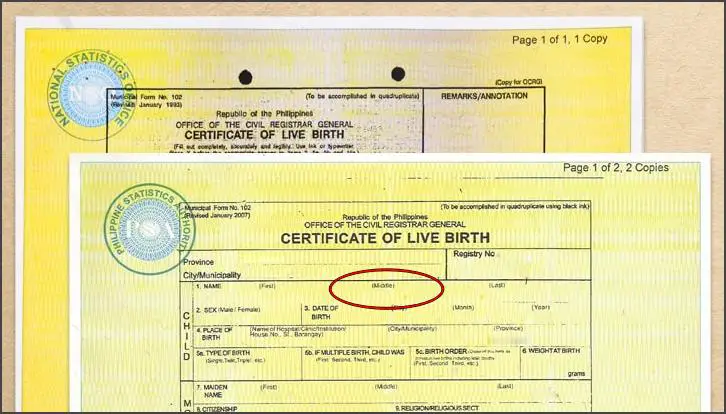A birth certificate is a crucial document that establishes your personal identity. However, what if it contains inaccuracies or omissions, such as a missing middle name? This issue can lead to misunderstandings or complications in legal and official proceedings. Ensuring the accuracy of your birth certificate is critical for avoiding such issues.
Also read: How to Register Live Birth at Civil Registrar Cebu City Civil Registrar
In the Philippines, there’s a solution for correcting these types of errors: a supplemental report filed with the Philippine Statistics Authority (PSA). This procedure allows you to amend your birth certificate, guaranteeing that your official records accurately represent your complete name and personal information.

What is a Supplemental Report?
Supplemental Report is a document used to provide additional information that was not included during registration. For instance, it can be helpful for adding a middle name that was left out on the birth certificate.
Types of Supplemental Report Based on the Child Status
The type of supplemental report you need to submit depends on your legal status as a child.
Here are the different scenarios:
a. Legitimate Child
If your birth certificate does not have a middle name, you will need to file a supplemental report for the missing information. Your name should be composed of your given first name and your father’s last name.
b. Illegitimate Child Acknowledged by the Father
If you fall under this category and your birth certificate lacks a middle name, you need to file a supplemental report using your mother’s last name as your middle name.
If the child does not have a middle name and the birth certificate lists the mother’s last name in the last name field, an Authority to Use the Surname of the Father (AUSF) can be filed at the Local Civil Registry (LCR). The requirements include:
- Private Handwritten Instrument (PHI)
- AUSF form, which will be provided by the LCR
c. Illegitimate Child Not Acknowledged by the Father
In this case, there is no requirement to provide a missing middle name. The child’s name should consist of his or her given name and the mother’s last name.
It’s important to ensure all your personal documents, including your birth certificate, accurately reflect your identity. Correcting any discrepancies can help avoid potential legal or administrative issues down the line.
Who May File Supplemental Report?
A supplemental report can only be filed by individuals aged 18 or older. Besides the person whose name is on the document, others who may file a supplemental report include:
- The document owner’s spouse
- The document owner’s children
- The document owner’s parents
- The document owner’s siblings
- The document owner’s grandparents
- The document owner’s legal guardian
- Any relative or other person who is legally authorized to file the report

It’s important to note that these parties must have a valid reason and necessary documentation when filing a supplemental report.
Where to File a Supplemental Report?
Where you file a supplemental report depends on your place of birth.
Here’s a brief guide:
a. Applicants Born in the Philippines
- If you were born in the Philippines, you need to file a supplemental report at the Local Civil Registry Office (LCRO) in the city or municipality where your birth was registered.
b. Applicants Born Abroad
- If you were born and are currently living outside the Philippines, regardless of whether you are legitimate or illegitimate, you must file a supplemental report with the Philippine Consulate.
- Legitimate children born outside the Philippines but currently residing in the Philippines should directly coordinate with the Philippine Embassy or Consulate where the birth was reported.
- Illegitimate children born outside the Philippines but currently residing in the Philippines must file through the Department of Foreign Affairs or the Office of Consular Affairs.
Knowing where to file is crucial for the smooth processing of your supplemental report. Always ensure that your documents are accurate and complete before submission.
What are the Documents Needed for Filing a Supplemental Report?
When filing a supplemental report, you must present the following documentary requirements along with their original copies:
- Three photocopies of your PSA birth certificate that shows the missing information.
- If filing with the Philippine Consulate, a photocopy of the data page of your passport is required.
- You also need to provide three photocopies of any three of the following identification documents:
- Passport
- Baptismal Certificate
- Voter’s ID or Voter’s Certificate
- Driver’s License
- School ID, School Records, Transcript of Records, or Diploma
- NBI or Police Clearance
- Company ID
- Employment Record
- Medical Records
- Other public or private documents or IDs that support the correction sought
Before filing, ensure all copies are clear and legible, and remember to bring the original documents for verification. Always double-check your requirements to avoid any delays in processing your supplemental report.
Also read: How to Claim PhilHealth Benefits in Hospital Bill
Application Process for Filing Supplemental Report
When you have gathered all necessary documents, you can proceed with the filing process. Please note that the procedure varies depending on whether you were born in the Philippines or abroad.
a. Application Process for Applicants Born in the Philippines
Step 1: Visit the Local Civil Registry Office (LCRO) and submit your documentary requirements.
Step 2: Pay the filing fees at the cashier.
Step 3: The LCRO will review your documents for any discrepancies or missing information.
Step 4: If your documents are complete, the LCRO will prepare the supplemental report and affidavit.
Step 5: The LCRO will issue copies of the supplemental report and an affidavit. You will then need to go to the PSA provincial office in your area, present the supplemental report, and request an endorsement of the document to the Office of the Civil Registrar General.
Step 6: Once you have the endorsement, send a copy of the supplemental report, affidavit, and endorsement letter to the Office of the Civil Registrar General via an official courier (JRS, LBC, or DHL). Keep the receipt of the transaction.
Step 7: After three working days, visit the Office of the Civil Registrar General to verify if the omitted entry has been added to your birth certificate. Bring the courier transaction receipt, your personal copy of the supplemental report, and your old PSA birth certificate.
b. Application Process for Applicants Born Abroad
Step 1: Proceed to the appropriate Philippine Consulate and submit the required documents.
Step 2: The Consular Officer will review your documents for any discrepancies or missing information.
Step 3: If your documents are complete, pay the filing fees at the cashier.
Step 4: The Consulate will prepare the supplemental report and affidavit.
Step 5: You will receive copies of the supplemental report and an affidavit. The Consular Officer will advise you on the next steps.
Please note that the LCRO or Consulate will only accept a supplemental report containing no more than two omitted entries. If there are more than two missing entries, you may need to coordinate with the Office of the Civil Registrar General and submit additional documents.
Also read: DSWD Programs and Services that Improve the Life of Every Filipino
Why is it Important to Have your Middle Name on your Birth Certificate?
A middle name on your birth certificate serves several important functions:
- Identity Verification: A middle name is critical for distinguishing individuals with similar first and last names. It reduces confusion and errors, particularly in legal, financial, and official contexts.
- Background Checks: When conducting background checks, having a middle name can improve the accuracy of the results and reduce false positives. It helps ensure that the correct individual’s information is being pulled up.
- Personalization: A middle name can add uniqueness to a person’s identity. It can be used to honor a family member, carry on a family name, or provide an alternative name a person can go by if they choose.
- Legal Necessity: In some contexts, a full legal name, which includes the middle name, is required. If it’s not on the birth certificate and there is no court order, you have no legal middle name.
- Genealogical Reasons: Middle names often carry significant familial or cultural information that can be helpful in tracing lineage or understanding family history.
Therefore, ensuring your middle name is correctly recorded on your birth certificate is important for both practical and personal reasons.
Video: How to Correct No Middle Name or Middle Initial in Birth Certificate in PSA or Civil Registrar
Summary
Ensuring that your birth certificate is accurate and complete is crucial when it comes to legal transactions. One common issue is a middle name that has not been included. If you encounter this problem, don’t fret. There are steps you can take to resolve it. Be proactive and contact the vital records department of the state where you were born. Determine the necessary documents you will need to provide and complete any required forms. With some patience and persistence, you can successfully update your birth certificate and move forward with confidence.